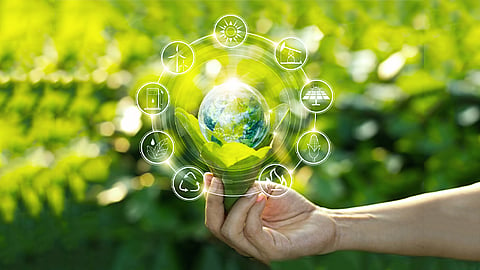
- News
- Women
- Magazine
- IndustryIndustry
- InsightsInsights
- Success Stories
- PublishPublish
- ContactContact
- Media KitMedia Kit

Sustainability and Real Estate: Designing a Greener Future
As we look to the future, the sustainability of our built environment is of paramount importance. The real estate, design, and construction industries have a vital role to play in ensuring that we create a world that is not only beautiful and functional, but also sustainable and resilient. The challenges we face are significant. Climate change, resource depletion, and environmental degradation are just a few of the issues that require urgent action. To address these challenges, we must embrace a new paradigm of design and construction, one that prioritizes sustainability and resilience at every step.
Sustainable real estate practices go beyond just the use of recycled materials and renewable energy sources. They encompass a range of considerations, from the materials used in construction to the design of the building itself. For example, by utilizing passive design strategies, such as designing for optimal solar orientation and natural ventilation, a building can reduce its energy consumption and carbon footprint without sacrificing comfort or convenience. To truly create meaningful change, we must critically evaluate and reimagine our current approaches to designing and constructing structures. As we move towards a more sustainable and compassionate future, it is crucial that we re-evaluate the way we approach the design and construction of our buildings. This involves considering not only their practicality but also their impact on the natural world, as well as their potential to enhance the health and happiness of the people who inhabit them. By prioritizing the needs and well-being of our communities, we can create structures that are not only functional, but also foster a sense of connection and harmony with our environment.
The implementation of green building certifications, such as Leadership in Energy and Environmental Design (LEED) and WELL, constitutes a critical pillar of sustainable real estate practices. These certifications offer a comprehensive framework for designing and constructing buildings that are not only energy-efficient and environmentally responsible but also prioritize the health and well-being of the building occupants. By setting standards for sustainable building design and operation, these certifications establish a benchmark for measuring a building's performance and enable the real estate industry to adopt sustainable practices that incentivize sustainable development. As such, the use of green building certifications plays a fundamental role in driving the transition towards a more sustainable built environment.
Another important aspect of sustainable real estate is the consideration of the building's lifecycle. A building's sustainability should be evaluated not just during the construction phase but also throughout its entire lifespan, from design to demolition. This includes considerations such as materials selection, maintenance, and recycling or repurposing at the end of the building's lifecycle.
Sustainability and real estate are closely intertwined. In addition to being a good corporate citizen, it is also an important part of any property owner's bottom line—therefore, it's crucial for any business-owner to be aware of these practices before deciding on an investment opportunity. With the increasing cost of energy and the rising expense of doing business, the need for sustainable solutions has become more important than ever. Today, we all recognize the significance of sustainability, whether it is for personal reasons or to promote to our customers. In light of this, investing in sustainable real estate has become a smart and profitable choice for the future. Not only does it support the environment, but it can also yield impressive financial returns.
Besides focusing on technical aspects, it's essential to acknowledge the social and economic dimensions of sustainability. We must prioritize promoting social equity, providing opportunities for jobs in sustainable industries, and investing in communities that have been historically marginalized. By recognizing and addressing these issues, we can create a more empathetic and inclusive approach towards sustainability that benefits everyone.
Sustainability is a collective responsibility that transcends any single industry or sector. It requires a shared commitment to preserve the health and well-being of our planet. Each one of us can play a vital role in safeguarding the future of our planet by adopting sustainable habits in our daily lives. Simple actions like reducing our energy consumption, minimizing waste production, and supporting sustainable businesses such as those that prioritize the use of renewable energy sources or implement sustainable supply chain practices. By these means, we can ensure that future generations inherit a healthier and more sustainable planet.
Ultimately, the challenges we face are not insurmountable. By working together, and embracing a shared vision of sustainability, we can create a world that is not only beautiful and functional, but also sustainable and resilient. Let us embrace this challenge with the same passion and determination as we have approached other great challenges throughout history, and create a better future for all.
Follow us on Google News
